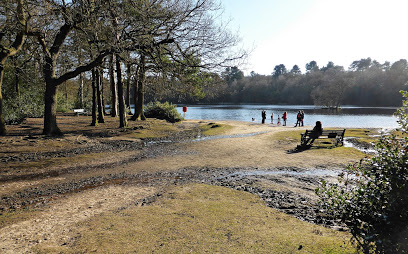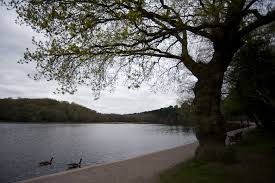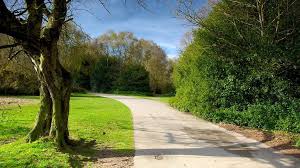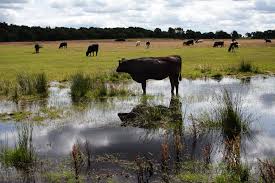It is designated as a Site of Special Scientific Interest.
The park has open heathland, woodlands, seven lakes, wetlands, and marshes - each with its own rich variety of plants and wildlife, some rarely seen in the region. Cattle and wild ponies graze on the land.
Attractions and sports facilities are marked on the Sutton Park map.
Sutton Park has been designated as a National Nature Reserve, a Scheduled Ancient Monument and a Site of Special Scientific Interest.
Heathland
Heathland covers 465 acres of Sutton Park, making it the second largest area of unbroken lowland heathland in Staffordshire and the West Midlands.
The heathland of Sutton Park is diverse, comprising dry and wet heathland areas, bog, mire and acid grassland.
Lowland heathland is a rare and threatened habitat. Heathland supports a wide variety of wildlife, and because of this it’s recognised nationally and internationally for its biodiversity.
Sutton Park was been grazed at a low level for centuries. This helped to keep the heathland in a healthy condition and created perfect conditions for heathland plants to thrive.
The heathland in Sutton Park has existed since at least since Roman times. Archaeologists have discovered evidence suggesting Ryknild Street (the Roman Road running through Sutton Park) was built on heathland.
Changes to grazing in Sutton Park have contributed to invasion by birch, gorse and bracken. Most of the areas covered in birch trees were open heathland up until 1976. A great fire led to about 50% of Sutton Park being destroyed. Grazing was not permitted over the next 2 years to allow the heathland to recover. Lack of grazing led to birch seedlings becoming established and coverage of large areas of heathland with woodland.
In 1989, work began to restore the heathlands. Large areas of birch trees and gorse were cleared from areas that should be open heathland. This work continues today.
Low level intensity grazing will help to preserve the health of the heathland into the future. We work hard to make sure that the right amount of livestock graze Sutton Park to keep invading scrubs at bay.
Lakes and fishing
Sutton Park has seven lakes, and thousands of anglers fish there every year. These lakes were man-made centuries ago to help to feed the local population.
Keepers Pool, Little Bracebridge Pool, Bracebridge Pool and Wyndley Pool were built in the Middle Ages to stock fish. They were constructed by damming small streams. The dam and the quarry created for their construction can still be seen.
Little Bracebridge may have been the site of fish stews, a shallow stretch of water where the fish were placed for fattening. Bracebridge Pool is believed to have been constructed by Sir Ralph Bracebridge, a ranger at the park during the reign of Henry V (1413-1422). The pool was granted to him on condition that he supplied the Earls of Warwick either 0 rent or 120 bream at 1/8d each. Bream, baked in flour and seasoned with spice, pepper, saffron cloves and cinnamon, was a favourite at the time.
Powell's is the largest lake in the park at 48 acres. It was created in 1730 when Sir Thomas Holte had the dam erected. The lake has large quantities of Canadian pond weed and blanket weed that provide a prolific source of food for the fish from the carp family such as bream, roach and tench. It also serves as a hiding place for the lake’s predators, pike and perch, which ambush other fish and wildlife from within the plants.
The marshes and reeds within the park are valuable habitats for many creatures that form part of the fishes' food chain. Algae and invertebrates which live on the reeds, as well as on the floating and submerged vegetation like the water lilies, bogbean and flag iris, form an integral part of the fishes' diet.
Blackroot Pool was possibly named after a blackened stump of an old oak tree near the centre of the pool. It is renowned as a carp water with both the common and mirror carp thriving there. The carp have been known to reach monster proportions with the largest specimen tipping the scales at 35lb 13oz. Pike, which are found in all the pools in the park, routinely reach sizes of around 20lb.
The park's streams are remarkably clean and they are able to support healthy populations of brown trout and bullhead.
History
Many features of Sutton Park date back over thousands of years and can be easily seen as you walk round the park.
Although the vegetation is “natural”, it is actually the result of thousands of years of human management. This management has left many well-preserved archaeological remains, such as earthworks - humps and bumps in the ground surface - which can easily be seen.
Neolithic Age
Over 6,000 years ago, people were living off wild food plants, hunting and fishing in the area around Sutton Park. They would have been nomadic people, living in structures which have left very little trace. Some of their flint tools have, however, been found near Little Bracebridge Pool and Rowton's Well.
Bronze Age
Six mounds near Streetly Lane, were exposed when the covering vegetation was burned by fire in 1926. Excavations showed that they were all composed of stones which had been shattered by heating many years before and that there were pits under the two largest mounds. Their date of origin is not known, but they are similar to the many 'burnt mounds' found in the midlands and other parts of the country during the Bronze Age about 3000 years ago.
These sites are thought to be the remains of steam or sauna bathing where hot stones were used to produce steam or of cooking where the stones were used to boil water.
While peat near Longmoor Pool was being dug for fuel in the 18th century, worked timbers were found near Rowton's Well. These may be part of a timber trackway similar to those built across wet areas elsewhere in Britain and Ireland in prehistoric times.
Iron Age
Iron Age remains are rarely found in the Birmingham area, but the ground surface under Sutton Park's Roman road shows what the landscape was like in the 1st century AD. Excavations revealed a soil type called a podzol which is found under heathland or light woodland.
Roman
Sutton Park’s Roman road is usually known as Ryknield Street. It’s about 1.5 mile long and was built as part of the Roman conquest of the West Midlands, just after the Roman army landed in Kent in AD 43.
It was a military road joining forts at Wall (near Lichfield) and Metchley, on Vincent Drive in Edgbaston. The road comes through north Birmingham by way of Handsworth, Perry Barr and Kingstanding, and enters Sutton Park near Banners Gate. It crosses the bog, heathland and golf course on the west side, leaving on the north side of the park. The road is best seen near the Royal Oak Gate off Chester Road North.
The most prominent part of the road today is a bank or agger, about 8m wide that formed the main road surface. Excavations have shown that it consists of compacted gravel, never having any sort of paved surface. Where it is best preserved, the agger is high and rounded.
There is an intermittent ditch along each side. This was built by Roman engineers as a laying out line to show where vegetation would have to be cleared away. Beyond the side ditches, there are pits and hollows where gravel was dug out to make the road.
Medieval period
Most ancient parks were created for the conservation and hunting of deer. One such forest, the forest of Kank (Cannock) extended from the River Tame to the Trent. In 1125, King Henry gave part of this forest to the Earls of Warwick. The area, from Spaghetti Junction to Shenstone and from Barr Beacon to Kingsbury was known as Sutton Chase - part of this was to become Sutton Park.
Wyndley Pool and Keepers Pool were probably constructed soon after the deer park was created in 1126. Bracebridge Pool is thought to have been constructed by Sir Ralph Bracebridge, a ranger during the reign of Henry V (1413 - 1422). Bracebridge Pool was granted to the ranger on condition he supplied the Earls of Warwick with either 0 rent or 120 bream at 1/8d.
Post-medieval period
Late in the 1520s, Sutton Park, as we know it today, came into being. Sutton Coldfield and its hunting grounds came into the possession of Henry VIII. In 1528 John Harman, a Sutton native who later became Bishop of Exeter, persuaded the King to grant a charter placing the administration of the town in the control of a warden and society. It also allowed the Bishop to enclose a section of the Chase as a park for the benefit of the inhabitants.
The Charter laid down that the inhabitants might 'freely hunt fish and fowl there, with dogs, bows and arrows, and with other engines for deer, stags, hares, foxes and other wild beasts.' The Royal Charter also allowed the townspeople to use the park to graze their animals.
In Bishop Vesey's time, there was no Town Gate. The original main road into the park went from the manor house on Manor Hill to Wyndley.
Sutton people treasured their heritage and fought against encroachments in 1581 and 1617.
In 1778, Sir Gilbert Scott of Great Barr set up a scheme to share all the 'waste', including the park, among the principal landowners. The townspeople successfully opposed the plan and the park was left untouched.
In 1756, Simon Luttrell of Four Oaks Hall Estate obtained an Act of Parliament enabling him to extend his park by annexing 48 acres of Sutton Park which adjoined his land. This changed the shape of the park forever.
Modern era
In 1827, Sir Edmund Hartop, who owned Four Oaks Hall, exchanged land with the Warden and Society, receiving 57 acres from the park and gave up just over 93 acres. The main advantage to the residents of Sutton Coldfield was that Sir Edmund agreed to construct Park Road and a new main entrance to the park. Another exchange in 1937 saw the trustees of the Somerville Estate convey land to the corporation bringing Powells Pool into the park.
The recreational use of Sutton Park began in the 19th century. There were two horse racing courses in the park. The first course was situated between Holly Knoll and the present day railway. A second, much larger, course was constructed near Westwood Coppice. Golf was introduced into Sutton Park by the Rector of Sutton Coldfield, the Rev W K Riland Bedford. The first nine hole golf course was built in 1880 around Meadow Platt and Holly Knoll. The 18 hole course on the Streetly side was established in 1889.
When the railway to Sutton Coldfield opened in 1862, special excursion trains for trippers to the park ran practically every day. Activities for the daytrippers included boating on the pools, donkey rides, refreshment rooms and swimming facilities. In 1868, Job Cole laid out some pleasure gardens near Wyndley Gate which were extended with refreshment rooms and overnight accommodation. In 1878, Cole set up the Crystal Palace company which could accommodate up to 2000 people for exhibitions and events: the fun fair proved particularly popular.
The park was used for military training in the 19th century. There was a volunteer camp near Streetly and a firing range was established near Westwood Coppice.
In the First World War, huts were built, first for the Birmingham City Battalion and then as convalescent camps for the Australian and New Zealand wounded. There was also a prisoner of war camp near Longmoor Pool. In the Second World War, the park was used as a training ground for the regular troops and the Home Guard, for testing tanks and as an internee camp for Italians and Germans.
In 1957 over 35,000 scouts from 37 different countries set up camp in the park for two weeks to celebrate the World Jubilee Jamboree. A stone to commemorate this event is still within the park.






